Fitzgerald A.E. Electric Machinery
Подождите немного. Документ загружается.


466 CHAPTER 9 Single- and Two-Phase Motors
As in Eq. 6.25, the electromagnetic torque
Tmain,f
of the forward field in newton-
meters equals 1/cos times the power Pgap,f in watts delivered by the stator winding to
the forward field, where COs is the synchronous angular velocity in mechanical radians
per second; thus
1
Tmain, f -- -- Pgap,f
(9.6)
(_0 s
When the magnetizing impedance is treated as purely inductive,
Pgap,f
is the power
absorbed by the impedance 0.5Zf; that is,
Pgap,f = 12(0.5Rf) (9.7)
where Rf is the resistive component of the forward-field impedance defined in Eq. 9.4.
Similarly, the internal torque
Tmain,b
of the backward field is
1
Tmain,b -- -- Pgap,b
(9.8)
O)s
where
Pgap,b
is the power delivered by the stator winding to the backward field, or
Pgap,b =
12
(0.5 Rb)
(9.9)
where Rb is the resistive component of the backward-field impedance Zb defined in
Eq. 9.5.
The torque of the backward field is in the opposite direction to that of the forward
field, and therefore the net internal torque Tmech is
1
Tmech -- Tmain,f - Tmain,b -" -- (Pgap,f - Pgap,b)
(9.10)
O.) s
Since the rotor currents produced by the two component air-gap fields are of
different frequencies, the total rotor
12R
loss is the numerical sum of the losses
caused by each field. In general, as shown by comparison of Eqs. 6.17 and 6.19, the
rotor
I ZR
loss caused by a rotating field equals the slip of the field times the power
absorbed from the stator. Thus
Forward-field rotor 12 R =
s Pgap,f
(9.11)
Backward-field rotor 12 R = (2 - s)
Pgap,b
(9.12)
Total rotor
12R = s Pgap,f +
(2
-
s)Pgap,b
(9.13)
Since power is torque times angular velocity and the angular velocity of the rotor
is (1 -
s)co~,
using Eq. 9.10, the internal power Pme~h converted to mechanical form,
in watts, is
emech ~- (l -- S)O-)sTmech -- (l -- s)(Pgap, f - Pgap,b)
(9.14)
As in the polyphase motor, the internal torque Tmech and internal power Pmech
are not the output values because rotational losses remain to be accounted for. It is
obviously correct to subtract friction and windage losses from Tmech or Pmech and it
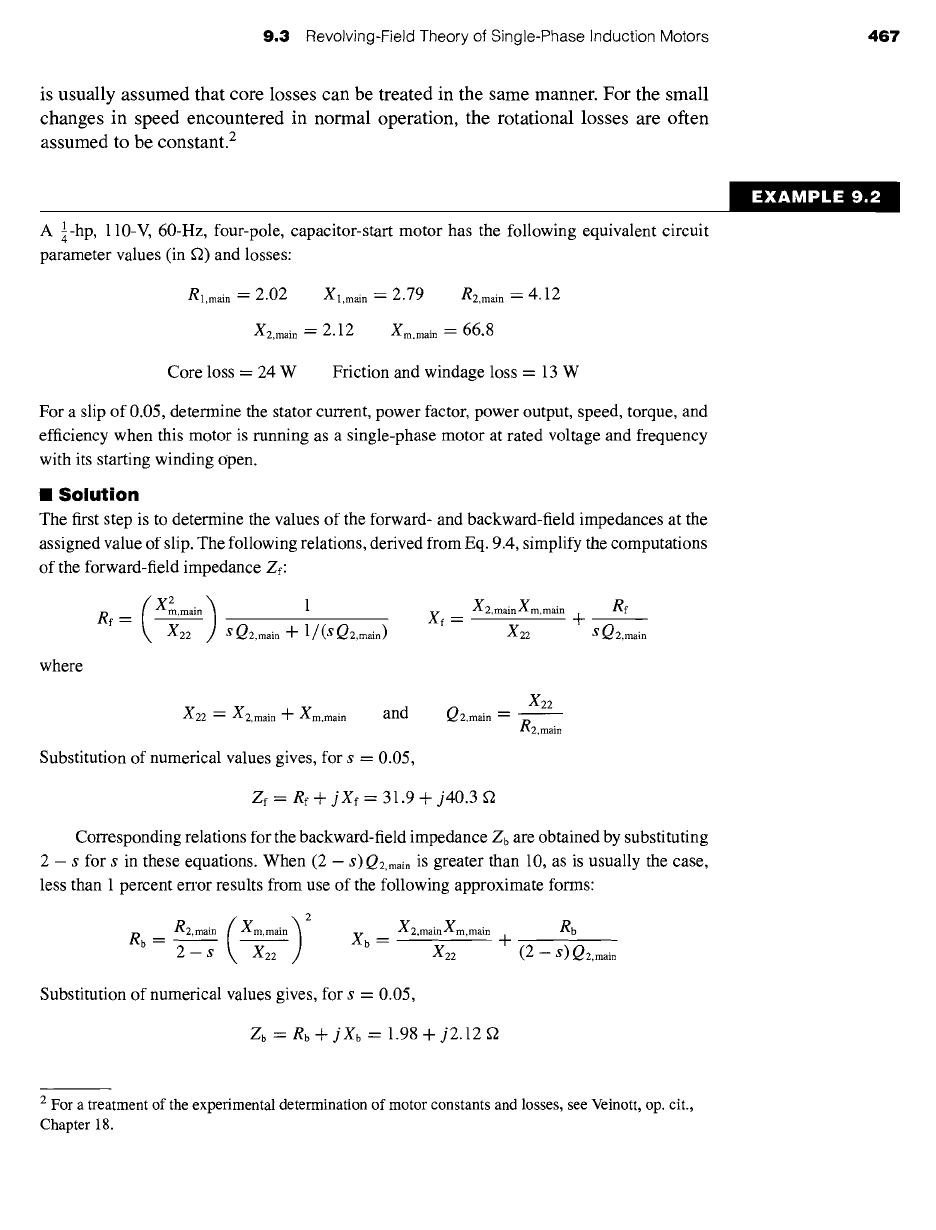
9.3 Revolving-Field Theory of Single-Phase Induction Motors
467
is usually assumed that core losses can be treated in the same manner. For the small
changes in speed encountered in normal operation, the rotational losses are often
assumed to be constant. 2
A ¼-hP, 110-V, 60-Hz, four-pole, capacitor-start motor has the following equivalent circuit
parameter values (in f2) and losses:
Rl,main =
2.02
Xl,main =
2.79
R2,main =
4.12
X2,main = 2.12 X .... in = 66.8
Core loss = 24 W Friction and windage loss = 13 W
For a slip of 0.05, determine the stator current, power factor, power output, speed, torque, and
efficiency when this motor is running as a single-phase motor at rated voltage and frequency
with its starting winding open.
n
Solution
The first step is to determine the values of the forward- and backward-field impedances at the
assigned value of slip. The following relations, derived from Eq. 9.4, simplify the computations
of the forward-field impedance Zf:
2 ) X2,mainX .... in Rf
Rf = X .... in 1 Xf = t
X22 s Q2,main +
1/(sQ2,main)
X22 sQ2,main
where
X22
X22 = X2,main Jr- X .... in and Q2,main - R2,mai n
Substitution of numerical values gives, for s = 0.05,
Zf --
Rf + jXf
=
31.9 + j40.3
Corresponding relations for the backward-field impedance
Z b are
obtained by substituting
2 - s for s in these equations. When (2
- s) a2,main
is greater than 10, as is usually the case,
less than 1 percent error results from use of the following approximate forms:
R2,main (X .... in) 2
Rb = 2~S X22
X2,main Xm,main Rb
Xb= +
X22 (2
-- S) Q2,main
Substitution of numerical values gives, for s = 0.05,
Zb -- Rb -+- jXb
= 1.98 +
j2.12
~2
EXAMPLE 9.2
2 For a treatment of the experimental determination of motor constants and losses, see Veinott, op. cit.,
Chapter 18.
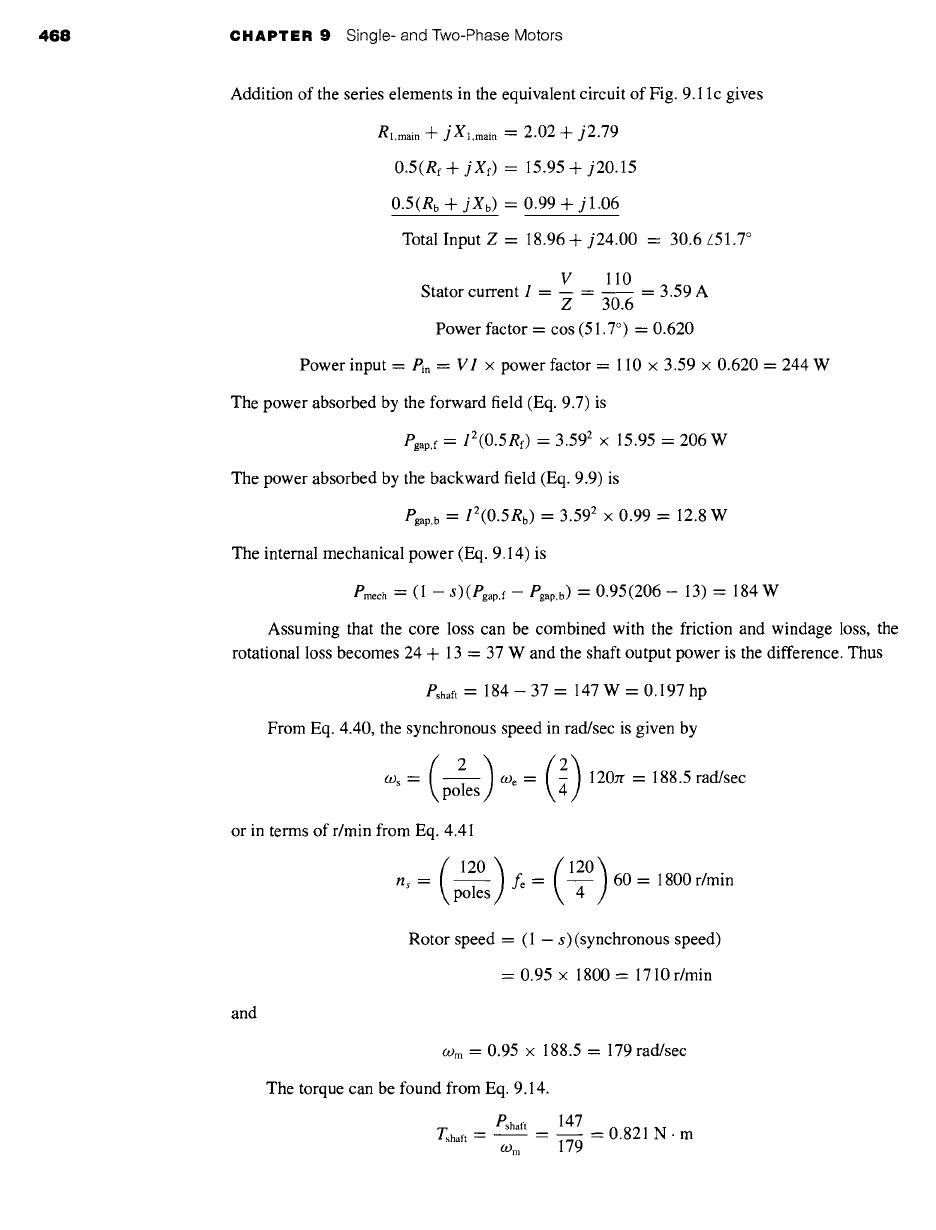
468 CHAPTER 9
Single- and Two-Phase Motors
Addition of the series elements in the equivalent circuit of Fig. 9.1 lc gives
Rl,main -~- j Xl,main =
2.02 + j2.79
0.5(Re +
jXf)
= 15.95
+ j20.15
0.5(Rb +
jXb)
= 0.99 + jl.06
Total Input Z = 18.96 + j24.00 = 30.6 Z51.7 °
V 110
Stator current I .... 3.59 A
Z 30.6
Power factor = cos (51.7 °) = 0.620
Power input
= Pin --
VI × power factor = 110 × 3.59 × 0.620 = 244 W
The power absorbed by the forward field (Eq. 9.7) is
egap,f =
12(0.5Re) = 3.592 × 15.95 = 206 W
The power absorbed by the backward field (Eq. 9.9) is
Pgap,b = 12(0.5Rb) = 3.592 × 0.99 = 12.8 W
The internal mechanical power (Eq. 9.14) is
Pmech
--
(1
- s)(Pgap,f-
Pgap,b) -"
0.95(206 - 13) = 184 W
Assuming that the core loss can be combined with the friction and windage loss, the
rotational loss becomes 24 + 13 = 37 W and the shaft output power is the difference. Thus
Pshaft = 184 -- 37 = 147 W = 0.197 hp
From Eq. 4.40, the synchronous speed in rad/sec is given by
ws= we= ~ 120n'= 188.5rad/sec
or in terms of r/min from Eq. 4.41
(l 0)
ns= ~ fe= --~ 60=1800r/min
Rotor speed = (1 - s)(synchronous speed)
= 0.95 × 1800 = 1710 r/min
and
COrn = 0.95 × 188.5 = 179 rad/sec
The torque can be found from Eq. 9.14.
Pshaft
147
T~haft -- = = 0.821 N- m
O.) m
179
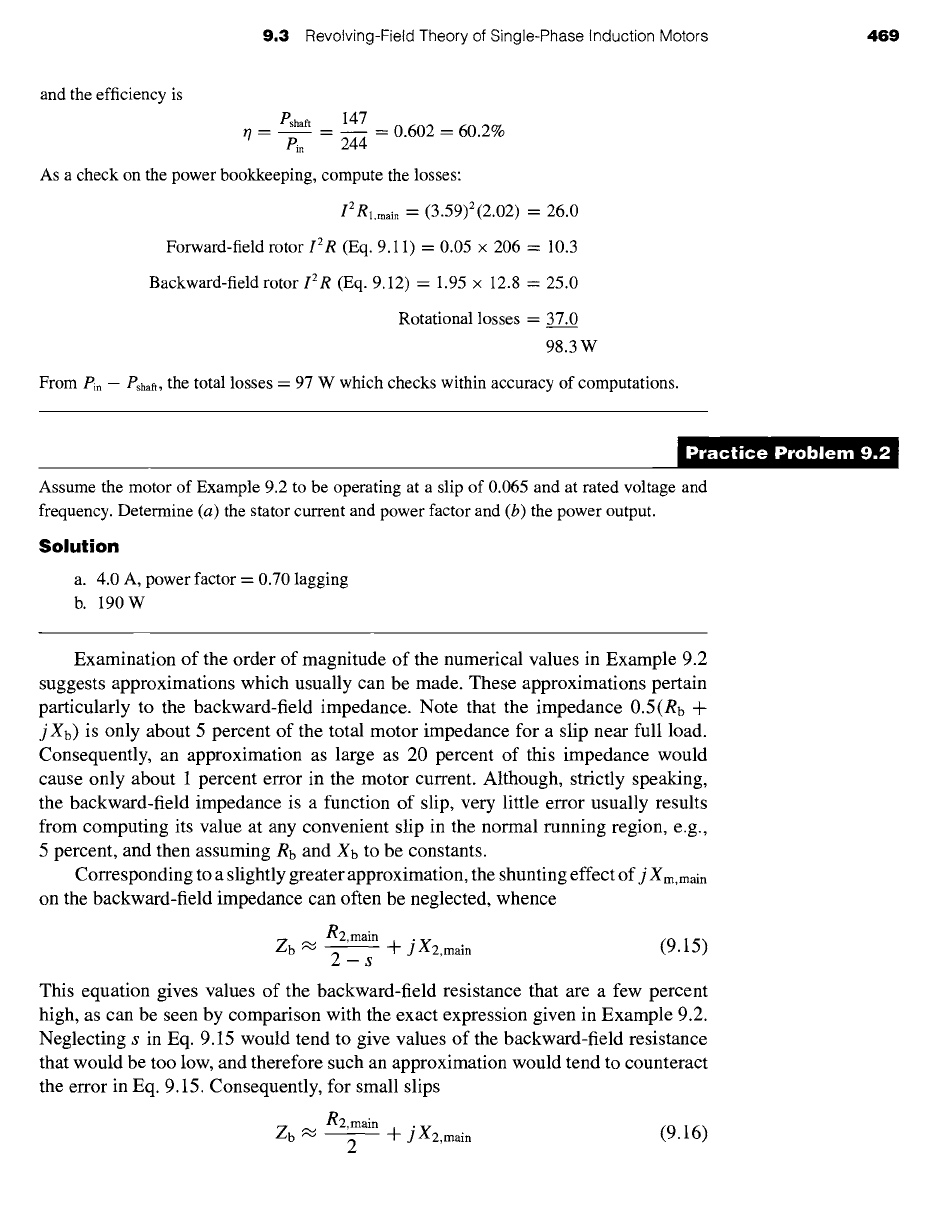
9.3 Revolving-Field Theory of Single-Phase Induction Motors 469
and the efficiency is
Pshaft
147
r/= = -- 0.602 = 60.2%
Pin 244
As a check on the power bookkeeping, compute the losses:
I2el,rnain =
(3.59)2(2.02) = 26.0
Forward-field rotor
12R
(Eq. 9.11) = 0.05 × 206 = 10.3
Backward-field rotor
I2R
(Eq. 9.12)-- 1.95 x 12.8 -- 25.0
Rotational losses = 37.0
98.3W
From
Pin -- Pshaft,
the total losses = 97 W which checks within accuracy of computations.
)ractice Problem 9.'
Assume the motor of Example 9.2 to be operating at a slip of 0.065 and at rated voltage and
frequency. Determine (a) the stator current and power factor and (b) the power output.
Solution
a. 4.0 A, power factor -- 0.70 lagging
b. 190W
Examination of the order of magnitude of the numerical values in Example 9.2
suggests approximations which usually can be made. These approximations pertain
particularly to the backward-field impedance. Note that the impedance 0.5(Rb +
j Xb) is only about 5 percent of the total motor impedance for a slip near full load.
Consequently, an approximation as large as 20 percent of this impedance would
cause only about 1 percent error in the motor current. Although, strictly speaking,
the backward-field impedance is a function of slip, very little error usually results
from computing its value at any convenient slip in the normal running region, e.g.,
5 percent, and then assuming
Rb
and Xb to be constants.
Corresponding to a slightly greater approximation, the shunting effect of j
Xm, main
on the backward-field impedance can often be neglected, whence
R2,main
Zb ~ ~ -F j Xz,main
(9.15)
2-s
This equation gives values of the backward-field resistance that are a few percent
high, as can be seen by comparison with the exact expression given in Example 9.2.
Neglecting s in Eq. 9.15 would tend to give values of the backward-field resistance
that would be too low, and therefore such an approximation would tend to counteract
the error in Eq. 9.15. Consequently, for small slips
R2,main
Zb "~ ~ -F j Xz,main
(9.16)
2

470 CHAPTER 9 Single- and Two-Phase Motors
In a polyphase motor (Section 6.5), the maximum internal torque and the slip at
which it occurs can easily be expressed in terms of the motor parameters; the maximum
internal torque is independent of rotor resistance. No such simple expressions exist
for a single-phase motor. The single-phase problem is much more involved because
of the presence of the backward field, the effect of which is twofold: (1) it absorbs
some of the applied voltage, thus reducing the voltage available for the forward field
and decreasing the forward torque developed; and (2) the backward field produces
negative torque, reducing the effective developed torque. Both of these effects depend
on rotor resistance as well as leakage reactance. Consequently, unlike the polyphase
motor, the maximum internal torque of a single-phase motor is influenced by rotor re-
sistance; increasing the rotor resistance decreases the maximum torque and increases
the slip at which maximum torque occurs.
Principally because of the effects of the backward field, a single-phase induction
motor is somewhat inferior to a polyphase motor using the same rotor and the same
stator core. The single-phase motor has a lower maximum torque which occurs at a
lower slip. For the same torque, the single-phase motor has a higher slip and greater
losses, largely because of the backward-field rotor
12R
loss. The volt-ampere input
to the single-phase motor is greater, principally because of the power and reactive
volt-amperes consumed by the backward field. The stator
12R
loss also is somewhat
higher in the single-phase motor, because one phase, rather than several, must carry all
the current. Because of the greater losses, the efficiency is lower, and the temperature
rise for the same torque is higher. A larger frame size must be used for a single-phase
motor than for a polyphase motor of the same power and speed rating. Because of
the larger frame size, the maximum torque can be made comparable with that of a
physically smaller but equally rated polyphase motor. In spite of the larger frame
size and the necessity for auxiliary starting arrangements, general-purpose single-
phase motors in the standard fractional-kilowatt ratings cost approximately the same
as correspondingly rated polyphase motors because of the much greater volume of
production of the former.
9.4 TWO-PHASE INDUCTION MOTORS
As we have seen, most single-phase induction motors are actually constructed in the
form of two-phase motors, with two stator windings in space quadrature. The main
and auxiliary windings are typically quite different, with a different number of turns,
wire size, and turns distribution. This difference, in combination with the capacitor
that is typically used in series with the auxiliary winding, guarantees that the mmfs
produced by the two winding currents will be quite unbalanced; at best they may
be balanced at one specific operating point. We will thus discuss various analytical
techniques for two-phase motors, both to expand our understanding and insight into
machine performance and also to develop techniques for the analysis of single- and
two-phase motors.
Under balanced operating conditions, a symmetrical two-phase motor can be
analyzed using techniques developed in Chapter 6 for three-phase motors, modified
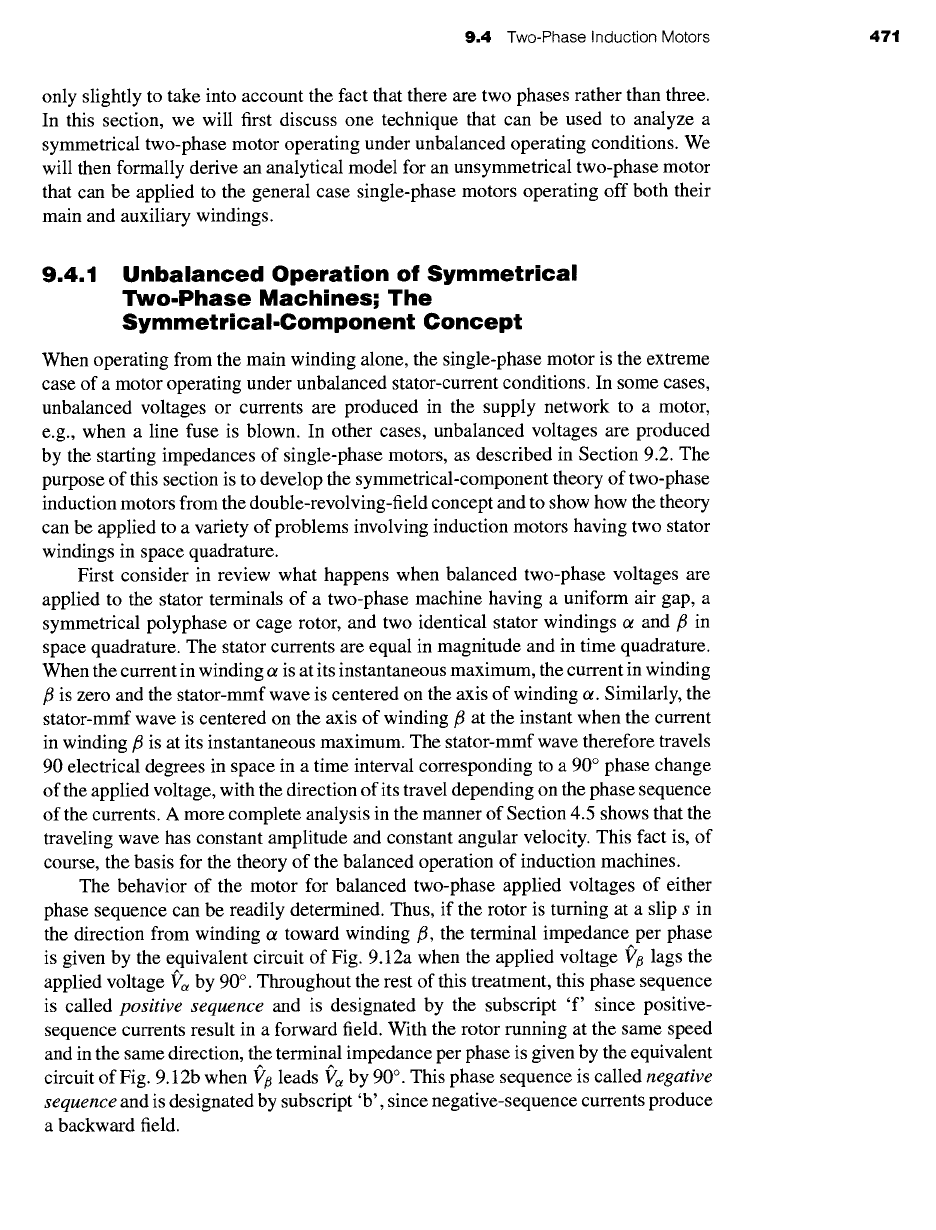
9.4 Two-Phase Induction Motors 471
only slightly to take into account the fact that there are two phases rather than three.
In this section, we will first discuss one technique that can be used to analyze a
symmetrical two-phase motor operating under unbalanced operating conditions. We
will then formally derive an analytical model for an unsymmetrical two-phase motor
that can be applied to the general case single-phase motors operating off both their
main and auxiliary windings.
9.4.1
Unbalanced Operation of Symmetrical
Two.Phase Machines; The
Symmetrical-Component Concept
When operating from the main winding alone, the single-phase motor is the extreme
case of a motor operating under unbalanced stator-current conditions. In some cases,
unbalanced voltages or currents are produced in the supply network to a motor,
e.g., when a line fuse is blown. In other cases, unbalanced voltages are produced
by the starting impedances of single-phase motors, as described in Section 9.2. The
purpose of this section is to develop the symmetrical-component theory of two-phase
induction motors from the double-revolving-field concept and to show how the theory
can be applied to a variety of problems involving induction motors having two stator
windings in space quadrature.
First consider in review what happens when balanced two-phase voltages are
applied to the stator terminals of a two-phase machine having a uniform air gap, a
symmetrical polyphase or cage rotor, and two identical stator windings ot and fl in
space quadrature. The stator currents are equal in magnitude and in time quadrature.
When the current in winding ot is at its instantaneous maximum, the current in winding
fl is zero and the stator-mmf wave is centered on the axis of winding or. Similarly, the
stator-mmf wave is centered on the axis of winding fl at the instant when the current
in winding fl is at its instantaneous maximum. The stator-mmf wave therefore travels
90 electrical degrees in space in a time interval corresponding to a 90 ° phase change
of the applied voltage, with the direction of its travel depending on the phase sequence
of the currents. A more complete analysis in the manner of Section 4.5 shows that the
traveling wave has constant amplitude and constant angular velocity. This fact is, of
course, the basis for the theory of the balanced operation of induction machines.
The behavior of the motor for balanced two-phase applied voltages of either
phase sequence can be readily determined. Thus, if the rotor is turning at a slip s in
the direction from winding ot toward winding r, the terminal impedance per phase
is given by the equivalent circuit of Fig. 9.12a when the applied voltage fz~ lags the
applied voltage fed by 90 ° . Throughout the rest of this treatment, this phase sequence
is called positive sequence and is designated by the subscript 'f' since positive-
sequence currents result in a forward field. With the rotor running at the same speed
and in the same direction, the terminal impedance per phase is given by the equivalent
circuit of Fig. 9.12b when fz~ leads fed by 90 °. This phase sequence is called negative
sequence and is designated by subscript 'b', since negative-sequence currents produce
a backward field.
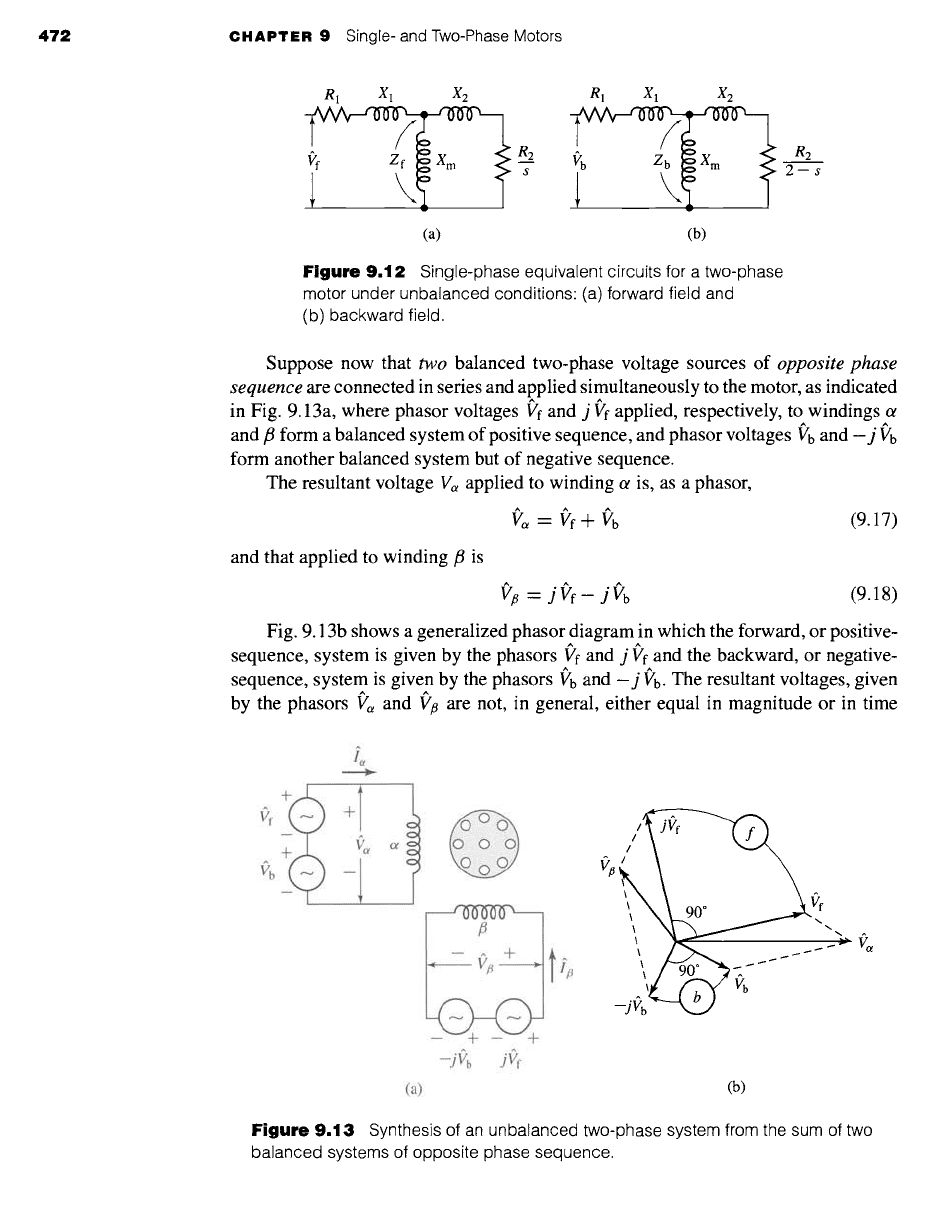
472 CHAPTER 9 Single- and Two-Phase Motors
R 1 X1 X2 R1 X1 X2
R2
S
(a) (b)
R2
2-s
Figure 9.12
Single-phase equivalent circuits for a two-phase
motor under unbalanced conditions (a) forward field and
(b) backward field.
Suppose now that two balanced two-phase voltage sources of
opposite phase
sequence are
connected in series and applied simultaneously to the motor, as indicated
in Fig. 9.13a, where phasor voltages Vf and j Vf applied, respectively, to windings ot
and fl form a balanced system of positive sequence, and phasor voltages "V'b and -j l?b
form another balanced system but of negative sequence.
The resultant voltage V,~ applied to winding ct is, as a phasor,
"i?~- (zf + l)b (9.17)
and that applied to winding fl is
'v'/~ = j'~'f- jl)b (9.18)
Fig. 9.13b shows a generalized phasor diagram in which the forward, or positive-
sequence, system is given by the phasors ~'r and j l~'r and the backward, or negative-
sequence, system is given by the phasors ~'b and -j ~'b. The resultant voltages, given
by the phasors 12~ and V/~ are not, in general, either equal in magnitude or in time
+
vb
Ot
,, iII1~
v ,,X \
\
-je ---xj
(a) (b)
Figure
9.13 Synthesis of an unbalanced two-phase system from the sum of two
balanced systems of opposite phase sequence.

9.4 Two-Phase Induction Motors 473
quadrature. From this discussion we see that an unbalanced two-phase system of
applied voltages V~ and V# can be synthesized by combining two balanced voltage
sets of opposite phase sequence.
The symmetrical-component systems are, however, much easier to work with than
their unbalanced resultant system. Thus, it is easy to compute the component currents
produced by each symmetrical-component system of applied voltages because the
induction motor operates as a balanced two-phase motor for each component system.
By superposition, the actual current in a winding then is the sum of its components.
Thus, if if and
Ib are,
respectively, the positive- and negative-sequence component
phasor currents in winding or, then the corresponding positive- and negative-sequence
component phasor currents in winding fl are, respectively, jif and -j ib, and the
actual winding currents i~ and i# are
Iot -- If 4- Ib (9.19)
/~ = j If - j ~?b (9.20)
The inverse operation of finding the symmetrical components of specified volt-
ages or currents must be performed often. Solution of Eqs. 9.17 and 9.18 for the
phasor components ~'f and t?b in terms of known phasor voltages fz and fz# gives
1
Vf = ~(V~ - jV/~) (9.21)
1
~'b- ~(V,~ 4- jV#) (9.22)
These operations are illustrated in the phasor diagram of Fig. 9.14. Obviously,
similar relations give the phasor symmetrical components if
and
Ib of the current in
winding ot in terms of specified phasor
currents i? m
and ia in the two phases; thus
^
If- ~(I~ - j~?/~) (9.23)
,,,,
ib -- ~(I~ 4-jI/~) (9.24)
.^
Figure 9.14 Resolution of unbalanced two-phase
voltages into symmetrical components.

474 CHAPTER
9 Single- and Two-Phase Motors
The equivalent-circuit parameters of a 5-hp 220-V 60-Hz four-pole two-phase squirrel-cage
induction motor in ohms per phase are
R1 = 0.534 X1 = 2.45 Xm = 70.1
R2 =
0.956
X 2 =
2.96
This motor is operated from an unbalanced two-phase 60-Hz source whose phase voltages
are, respectively, 230 and 210 V, the smaller voltage leading the larger by 80 °. For a slip of
0.05, find (a) the positive- and negative-sequence components of the applied voltages, (b) the
positive- and negative-sequence components of the stator-phase currents, (c) the effective values
of the phase currents, and (d) the internal mechanical power.
II Solution
We will solve this example using MATLAB. t
a. Let f'~ and f'~ denote the voltages applied to the two phases, respectively. Then
I~'~ = 230Z0 ° = 230 + j0 V
f,'~ = 210Z80 ° = 36.4 + j207 V
From Eqs. 9.21 and 9.22 the forward and backward components of voltages are,
respectively,
f"f -- 218.4- j18.2-- 219.2/-4.8 ° V
fZb -- 11.6 + j 18.2 -- 21.6/57.5 ° V
b. Because of the ease with which MATLAB handles complex numbers, there is no need to
use approximations such as are derived in Example 9.2. Rather, the forward- and
backward-field input impedances of the motor can be calculated from the equivalent
circuits of Figs. 9.12a and b. Dividing the forward-field voltage by the forward-field input
impedance gives
it. = - 9.3 - j6.3 = 11.2z -34.2 ° A
Ri + j Xi + Zr
Similarly, dividing the backward-field voltage by the backward-field input
impedance gives
lb = f/b = 3.7 -- j l.5 = 4.0" --21.9 ° A
Ri + j Xi + Zb
c. The winding currents can be calculated from Eqs. 9.19 and 9.20
i~, -- ir + ib = 13.0--j7.8 = 15.2/-31.0"A
7~ = jlr- jib -- 4.8 + j5.6 = 7.4/49.1" A
Note that the winding currents are much more unbalanced than the applied voltages.
Even though the motor is not overloaded insofar as shaft load is concerned, the losses are
t MATLAB is a registered trademark of The MathWorks, Inc.
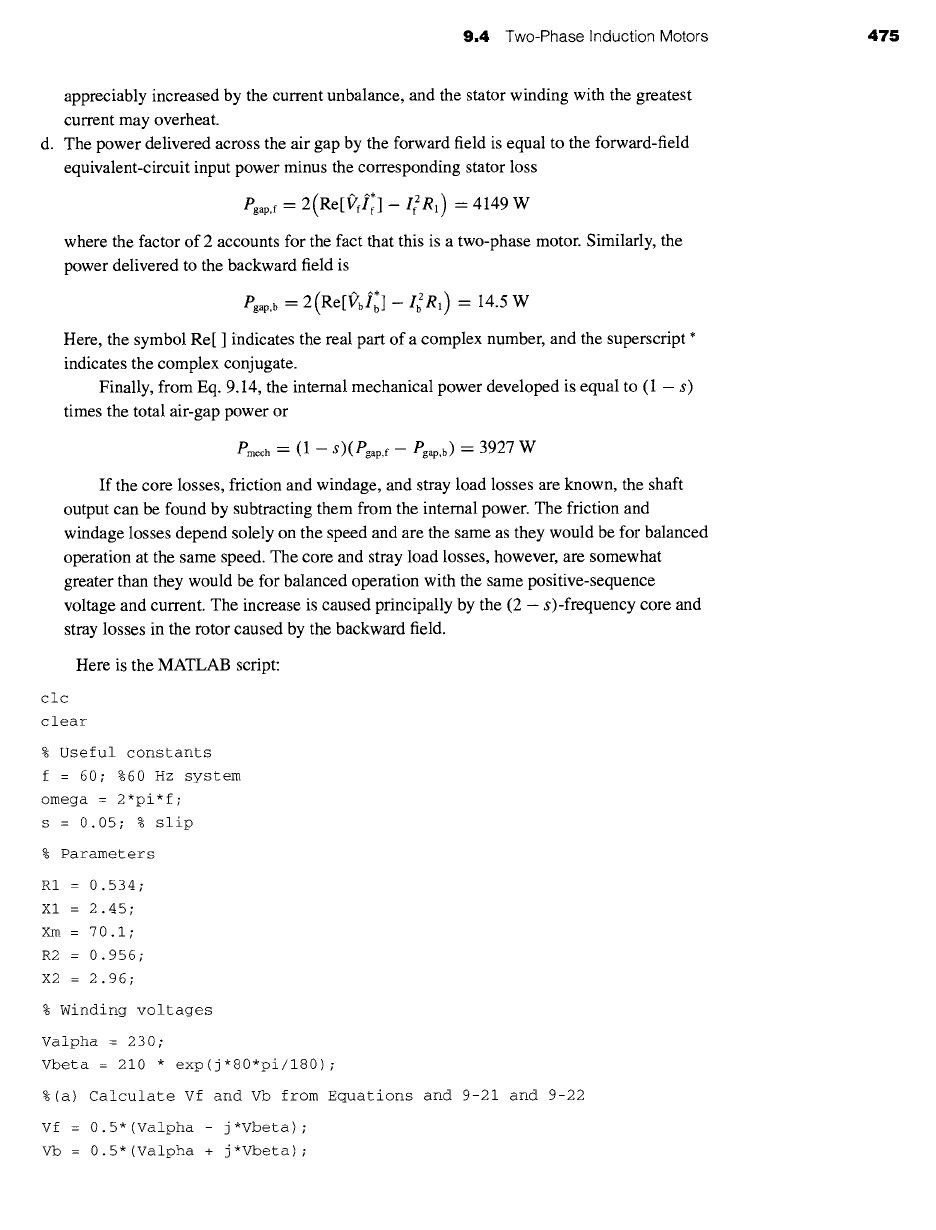
9,4 Two-Phase Induction Motors 475
appreciably increased by the current unbalance, and the stator winding with the greatest
current may overheat.
d. The power delivered across the air gap by the forward field is equal to the forward-field
equivalent-circuit input power minus the corresponding stator loss
Pgap,f = 2(Retl~'fl~]-
12R,)
= 4149 W
where the factor of 2 accounts for the fact that this is a two-phase motor. Similarly, the
power delivered to the backward field is
egap,b--
2(Re[I3"bi~]-
I~R,)
: 14.5 W
Here, the symbol Re[ ] indicates the real part of a complex number, and the superscript *
indicates the complex conjugate.
Finally, from Eq. 9.14, the internal mechanical power developed is equal to (1 - s)
times the total air-gap power or
Pmech = (1 --s)(egap,f- Pgap,b) =
3927 W
If the core losses, friction and windage, and stray load losses are known, the shaft
output can be found by subtracting them from the internal power. The friction and
windage losses depend solely on the speed and are the same as they would be for balanced
operation at the same speed. The core and stray load losses, however, are somewhat
greater than they would be for balanced operation with the same positive-sequence
voltage and current. The increase is caused principally by the (2 - s)-frequency core and
stray losses in the rotor caused by the backward field.
Here is the MATLAB script:
clc
clear
% Useful constants
f = 60; %60 Hz system
omega = 2*pi*f;
s = 0.05; % slip
% Parameters
R1 = 0.534;
Xl = 2.45;
Xm = 70.1;
R2 = 0.956;
X2 = 2.96;
% Winding voltages
Valpha = 230;
Vbeta = 210 * exp(j*80*pi/180);
%(a) Calculate Vf and Vb from Equations and 9-21 and 9-22
Vf = 0.5*(Valpha - j*Vbeta) ;
Vb = 0.5*(Valpha + j*Vbeta) ;
